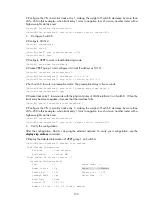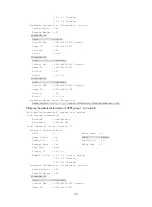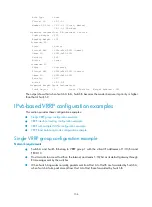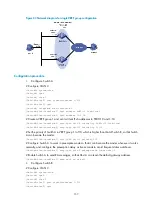
163
Run Mode : Standard
Run Method : Virtual MAC
Total number of virtual routers : 1
Interface Vlan-interface2
VRID : 1 Adver Timer : 400
Admin Status : Up State : Master
Config Pri : 100 Running Pri : 100
Preempt Mode : Yes Delay Time : 5
Auth Type : Simple Key : hello
Virtual IP : FE80::10
1::10
Virtual MAC : 0000-5e00-0201
Master IP : FE80::2
The output shows that when VLAN-interface 3 on Switch A is not available, the priority of Switch A is
reduced to 80 and Switch A becomes the backup. Switch B becomes the master and packets sent from
Host A to Host B are forwarded by Switch B.
VRRP with multiple VLANs configuration example
Network requirements
•
Switch A and Switch B belong to both VRRP group 1 and VRRP group 2. The virtual IPv6 addresses
of VRRP group 1 are 1::10/64 and FE80::10, and those of VRRP group 2 are 2::10/64 and
FE90::10.
•
Hosts in VLAN 2 learn 1::10/64 as their default gateway and hosts in VLAN 3 learn 2::10/64 as
their default gateway through RA messages sent by the switches.
•
In VRRP group 1, Switch A has a higher priority than Switch B. In VRRP group 2, Switch B has a
higher priority than Switch A. In this case, hosts in VLAN 1 and VLAN can communicate with
external networks through Switch A and Switch B respectively, and when Switch A or Switch B fails,
the hosts can use the other switch to communicate with external networks to avoid communication
interruption.
Figure 45
Network diagram for configuration of multiple VRRP groups in different VLANs
















































